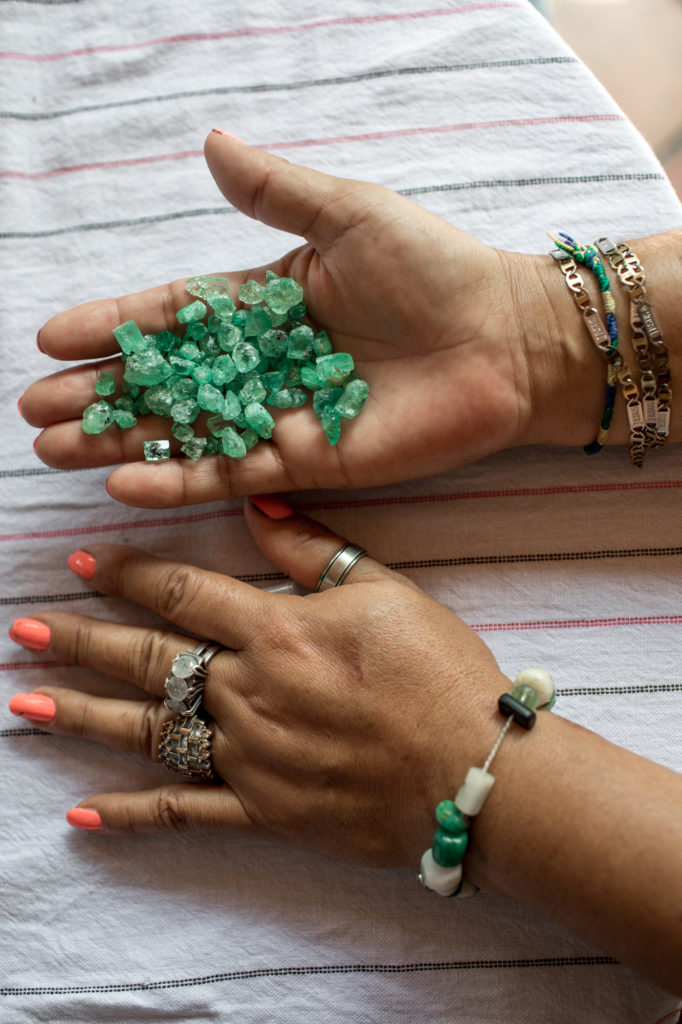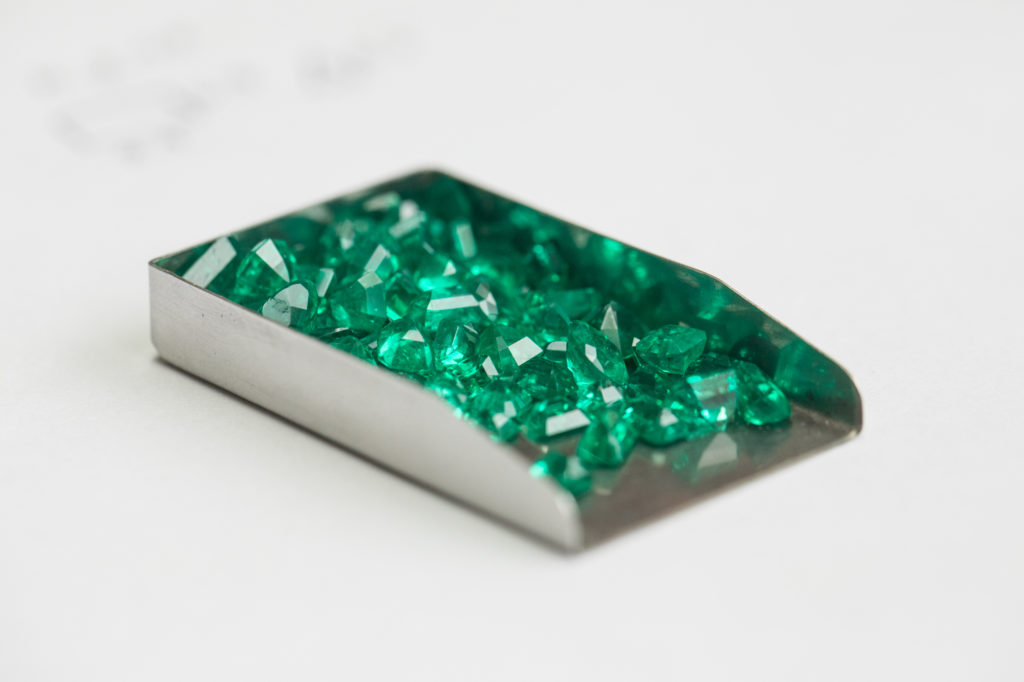Emerald – the majestic May birthstone

Emeralds are fast becoming one of the most popular gemstones and they are focus in the month of May as its recognised birthstone. Emeralds are a notoriously hazardous stone to cut and polish because they can crack, or cleave, easily. All examples contain fissures and a highly skilled craftsman must fashion the rough stone by cutting it according to the disposition of these small fractures within the gem to achieve the best results. It is for this reason the familiar rectangular “emerald cut,” with concentrically faceted corners, is most often associated with this stone because it maximises the original emerald crystal, reduces the chance of chipping or cracking and provides a stable surface for claws and prongs. At 7.5 to 8 on the (1-10) Mohs scale of gem hardness, it is important to remember that emeralds are more vulnerable to damage than the much harder diamond (which is to be found at 10 on the Mohs). Due to the dramatic increase in the value of a stone with optimal colour and clarity enhancements, several methods of enhancement are used. Some stones are simply dyed to appear more vivid and the colour of these emeralds will degrade significantly over time. By far the most common of all emerald treatments involves fracture filling, where surface reaching fissures are be smoothed in appearance by the addition of oils, waxes, and resins. It is recommended to look for stones that are classed as ‘no-oil’ to ‘insignificant’ / ‘minor’ oil, as heavily oiled examples can become unstable and deteriorate over time. It is better refrain from exposing a treated emerald to heat (including washing up water and baths or showers), changes in air pressure (such as in an aircraft cabin) and chemicals. Never use an ultrasonic cleaner, simply apply a soft, damp cloth very gently.

Emerald’s story goes back a very long way. For thousands of years emerald green has been used as the benchmark against which other green gemstones have been measured. Emerald is the green to bluish-green variety of the beryl family of gemstones, a species which also includes aquamarine and many other different coloured varieties, such as red, yellow, and green beryl. The green colouration comes from the presence of trace elements of chromium, vanadium, and iron within the stone and the higher the chromium or vanadium content, the more intense the green. The presence of iron creates the bluish-green tones and the greater the iron content, the more bluish colouration will appear in the stone. The boundary between a green beryl and an emerald is somewhat blurred and many experts disagree on exactly where it lies. In broad terms, light green examples are referred to as green beryl, whereas deeper hues are regarded as the much more coveted emerald variety. It is worth noting that the many of the leading gemmological laboratories, including the GIA, Gübelin and SSEF, have predefined limits demarcating emerald from green beryl by the depth of their colour. Unlike diamonds, all emeralds contain inclusions, so it is the colour, depth of colour, tone, saturation, hue, and transparency that are the key determiners of desirability and therefore value.

Emeralds have adorned the jewellery collections of the rich and powerful dating back to the ancient civilisations. Cleopatra went as far as creating 3 emerald mines exclusively to provide stones for her personal use, putting to death anyone who attempted to sell the stones elsewhere. Across the Atlantic the Aztec, Inca and Mayan civilisations mined emeralds in vast quantities, a source of production that was quickly taken over by the colonising Spanish conquistadors from the late fifteenth century onwards. The Crown of the Andes, perhaps the most famous emerald adorned piece of all, was created by the European settlers in honour of their religious convictions. A number of Spanish and Portuguese galleons laden with emeralds and other jewels have been discovered in recent decades, such as the Nuestra Señora de Atocha, which was found off the Florida Keys in 1985. This has added to the mystique and allure of this green gemstone. The etymology of the word “emerald” derives from the ancient Greek word for a green gemstone. Indeed, the fascination with emerald and its use as the May birthstone was also highlighted by the Roman scholar Pliny the Elder, who later fell victim to the AD79 eruption of Mount Vesuvius. Pliny stated that “nothing greens greener” and he described how gem cutters “have no better method of restoring their eyes than by looking at the emerald, its soft, green colour comforting and removing their weariness and lassitude.”

Modern science has proved that Pliny was correct in that the colour green has been proven to relieve stress and reduce eye strain, one of the reasons it is now used in the cockpits of aircraft and the dashboards of vehicles. As well as being the May birthstone, emerald is also associated with 20th and 35th anniversaries. Colombia has been the place of origin for the most prized emeralds for over half a millennium. The three most significant mining regions within the country are Muzo, Chivor and Coscuez. Each of these regions produces a subtly different tone and hue of emerald but in general the darker, more deeply coloured stones originate from Muzo. By contrast, slightly lighter and more bluish-green examples tend to be found in Chivor, whilst stones from Coscuez are associated with a yellowish-green hue. Emeralds are also found in significant volumes in Minas Gerais, Brazil, as well as Zambia, Ethiopia, Tanzania, Afghanistan, and Pakistan. As with most coloured gemstones, colour is the most important determiner of the price of an emerald. The premium stones display a vivid colour saturation and a medium dark tone, with high transparency (resembling a green wine bottle held to the sun). Nearly all-natural emeralds contain inclusions that are visible to the naked eye and in fact a totally ‘loupe-clean’ emerald is likely to be synthetic. It is only when the level of eye-visible inclusions begins to affect the transparency and clarity of a stone that they begin to deflate its value.
Read more about emeralds at www.londonde.com/blog.


